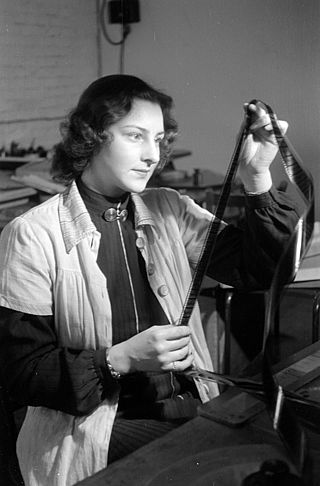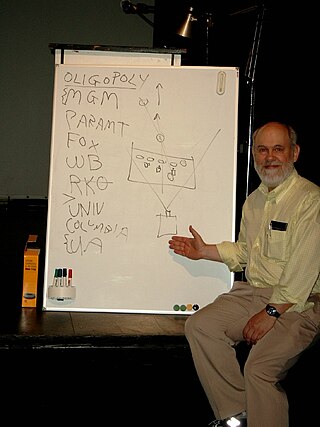
Film editing is both a creative and a technical part of the post-production process of filmmaking. The term is derived from the traditional process of working with film which increasingly involves the use of digital technology. When putting together some sort of video composition, typically, you would need a collection of shots and footages that vary from one another. The act of adjusting the shots you have already taken, and turning them into something new is known as film editing.
Formalist film theory is an approach to film theory that is focused on the formal or technical elements of a film: i.e., the lighting, scoring, sound and set design, use of color, shot composition, and editing. This approach was proposed by Hugo Münsterberg, Rudolf Arnheim, Sergei Eisenstein, and Béla Balázs. Today, it is a major approach in film studies.
Film style refers to recognizable cinematic techniques used by filmmakers to create specific value in their work. These techniques can include all aspects of film language, including: sound design, mise-en-scène, dialogue, cinematography, editing, or direction.

A jump cut is a cut in film editing that breaks a single continuous sequential shot of a subject into two parts, with a piece of footage removed to create the effect of jumping forward in time. Camera positioning on the subject across the sequence should vary only slightly to achieve the effect. The technique manipulates temporal space using the duration of a single shot—fracturing the duration to move the audience ahead. This kind of cut abruptly communicates the passing of time, as opposed to the more seamless dissolve heavily used in films predating Jean-Luc Godard's Breathless, which extensively used jump cuts and popularized the technique in the 1960s. For this reason, jump cuts are considered a violation of classical continuity editing, which aims to give the appearance of continuous time and space in the story-world by de-emphasizing editing, but are sometimes nonetheless used for creative purposes. Jump cuts tend to draw attention to the constructed nature of the film. More than one jump cut is sometimes used in a single sequence.
The New Wave, also called the French New Wave, is a French art film movement that emerged in the late 1950s. The movement was characterized by its rejection of traditional filmmaking conventions in favor of experimentation and a spirit of iconoclasm. New Wave filmmakers explored new approaches to editing, visual style, and narrative, as well as engagement with the social and political upheavals of the era, often making use of irony or exploring existential themes. The New Wave is often considered one of the most influential movements in the history of cinema.

A film transition is a technique used in the post-production process of film editing and video editing by which scenes or shots are combined. Most commonly this is through a normal cut to the next shot. Most films will also include selective use of other transitions, usually to convey a tone or mood, suggest the passage of time, or separate parts of the story. These other transitions may include dissolves, L cuts, fades, match cuts, and wipes.
Cross-cutting is an editing technique most often used in films to establish action occurring at the same time, and often in the same place. In a cross-cut, the camera will cut away from one action to another action, which can suggest the simultaneity of these two actions but this is not always the case. Cross-cutting can also be used for characters in a film with the same goals but different ways of achieving them.
In filmmaking and video production, a shot is a series of frames that runs for an uninterrupted period of time. Film shots are an essential aspect of a movie where angles, transitions and cuts are used to further express emotion, ideas and movement. The term "shot" can refer to two different parts of the filmmaking process:
- In production, a shot is the moment that the camera starts rolling until the moment it stops.
- In film editing, a shot is the continuous footage or sequence between two edits or cuts.

In filmmaking, the 180-degree rule is a basic guideline regarding the on-screen spatial relationship between a character and another character or object within a scene. The rule states that the camera should be kept on one side of an imaginary axis between two characters, so that the first character is always frame right of the second character. Moving the camera over the axis is called jumping the line or crossing the line; breaking the 180-degree rule by shooting on all sides is known as shooting in the round.
Continuity editing is the process, in film and video creation, of combining more-or-less related shots, or different components cut from a single shot, into a sequence to direct the viewer's attention to a pre-existing consistency of story across both time and physical location. Often used in feature films, continuity editing, or "cutting to continuity", can be contrasted with approaches such as montage, with which the editor aims to generate, in the mind of the viewer, new associations among the various shots that can then be of entirely different subjects, or at least of subjects less closely related than would be required for the continuity approach. When discussed in reference to classical Hollywood cinema, it may also be referred to as classical continuity.
Narrative film, fictional film or fiction film is a motion picture that tells a fictional or fictionalized story, event or narrative. Commercial narrative films with running times of over an hour are often referred to as feature films, or feature-length films. The earliest narrative films, around the turn of the 20th century, were essentially filmed stage plays and for the first three or four decades these commercial productions drew heavily upon the centuries-old theatrical tradition.

Classical Hollywood cinema is a term used in film criticism to describe both a narrative and visual style of filmmaking which first developed in the 1910s to 1920s during the latter years of the silent film era. It then became characteristic of American cinema during the Golden Age of Hollywood, between roughly 1927 to 1969. It eventually became the most powerful and pervasive style of filmmaking worldwide.
This article contains a list of cinematic techniques that are divided into categories and briefly described.

The 30-degree rule is a basic film editing guideline that states the camera should move at least 30 degrees relative to the subject between successive shots of the same subject. If the camera moves less than 30 degrees, the transition between shots can look like a jump cut—which could jar the audience and take them out of the story. The audience might focus on the film technique rather than the narrative itself.

David Jay Bordwell is an American film theorist and film historian. Since receiving his PhD from the University of Iowa in 1974, he has written more than fifteen volumes on the subject of cinema including Narration in the Fiction Film (1985), Ozu and the Poetics of Cinema (1988), Making Meaning (1989), and On the History of Film Style (1997).
French impressionist cinema refers to a group of French films and filmmakers of the 1920s.
In the post-production process of film editing and video editing, a cut is an abrupt, but usually trivial film transition from one sequence to another. It is synonymous with the term edit, though "edit" can imply any number of transitions or effects. The cut, dissolve, and wipe serve as the three primary transitions. The term refers to the physical action of cutting film or videotape, but also refers to a similar edit performed in software; it has also become associated with the resulting visual "break".
The psychology of film is a sub-field of the psychology of art that studies the characteristics of film and its production in relation to perception, cognition, narrative understanding, and emotion. A growing number of psychological scientists and brain scientists have begun conducting empirical studies that describe the cognitive and biological underpinnings of motion pictures or what has been called "psychocinematics". Early theoretical approaches included works by psychologists Hugo Münsterberg and Rudolf Arnheim. Cognitive film theorists David Bordwell and Noël Carroll fostered its philosophical underpinnings.
In film studies, historical poetics is a scholarly approach to studying film, which David Bordwell outlined in his book Making Meaning (1989). Poetics studies the text itself rather than its production, reception or cultural significance and it can therefore be seen as a logical first step - though expressly not the last step - in terms of understanding how a narrative text works.
This glossary of motion picture terms is a list of definitions of terms and concepts related to motion pictures, filmmaking, cinematography, and the film industry in general.






